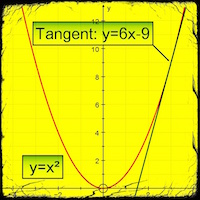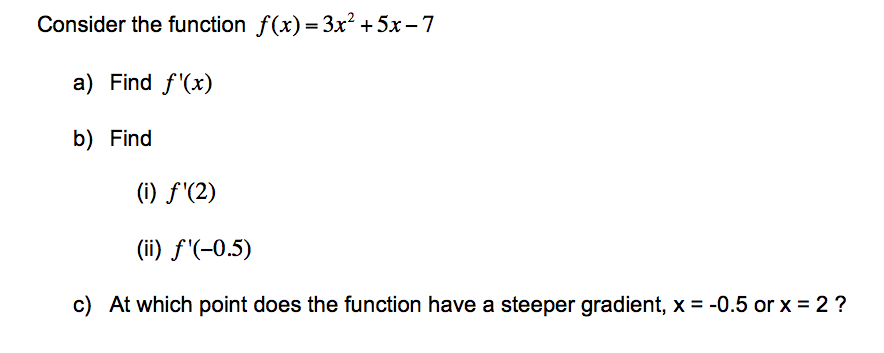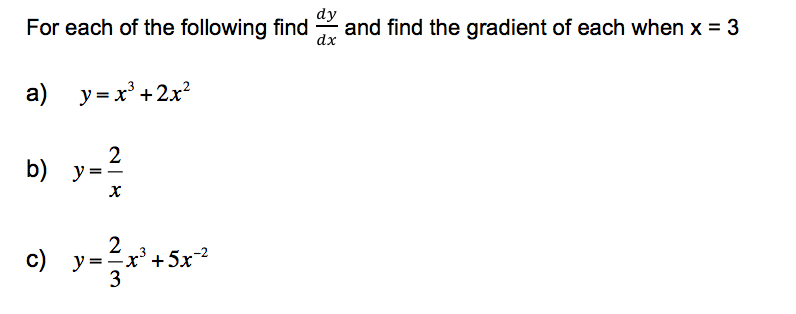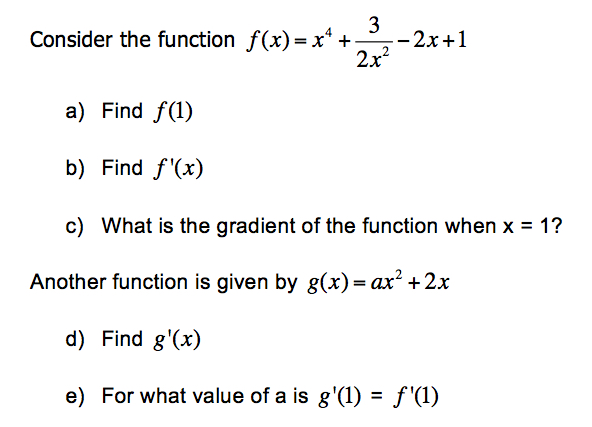 Differentiating
Differentiating
This is the first of three sections on differential calculus. This is significant branch of mathematics with lots of applications. It builds very nicely on other concepts in the course and those you are likely to have covered previously. The whole principle is based around examining 'Rates of change'.
Learn about it
The following is a series of slides and videos that will help you understand, learn about and review this sub-topic.
Keep track of your progress and practice the exam questions on this ![]() Calculus concept record sheet
Calculus concept record sheet
Slides Gallery
Use these slides to review the material and key points covered in the videos.
 Introduction - what is calculus about
Introduction - what is calculus about
This video puts the whole idea in to some context and shows how calculus bulds carefully on work already done.
 The Gradient function
The Gradient function
Here we introduce the idea of deriving a function which tells about the gradient of the function we started with.
 Differentiating polynomials
Differentiating polynomials
At this point we move on to the general pattern for deriving the gradient function.
Negative indices and differentiating
This is a focus on dealing with negative indices. They are a potential pitfall, but if you are careful there should be no problem.
 Finding gradients
Finding gradients
Here we apply the techniques to find the gradient of a given function at any point.
 Revise
Revise
This section of the page can be used for quick review. The flashcards help you go over key points and the quiz lets you practice answering questions on this subtopic.
Flash Cards
Review these condensed 'key point' flashcards to help you check and keep ideas fresh in your mind.
Quiz
Practice your understanding on these quiz questions. Check your answers when you are done and read the hints where you got stuck. If you find there are still some gaps in your understanding then go back to the videos and slides above.
Exam Style Questions
The following questions are based on IB exam style questions from past exams. You should print these off (from the document at the top) and try to do these questions under exam conditions. Then you can check your work with the video solution.
Question 1
Question 2
Question 3
.....



































 for which
for which  . What are the values of a and b?
. What are the values of a and b?
 for which
for which  , for which
, for which  . What are the values of a, b and c
. What are the values of a, b and c , for which
, for which  . What are the values of a, b, c and d
. What are the values of a, b, c and d can also be written as
can also be written as  , what are the values of a, b and c?
, what are the values of a, b and c?
 , for which
, for which  . What are the values of a, b, c and d? (do it on paper and be careful with the signs)
. What are the values of a, b, c and d? (do it on paper and be careful with the signs)
 when x = 2?
when x = 2?
 when x = -3?
when x = -3?
 find
find  to 3sf
to 3sf 159 to 3sf (use the table function on your GDC
159 to 3sf (use the table function on your GDC


 Twitter
Twitter  Facebook
Facebook  LinkedIn
LinkedIn